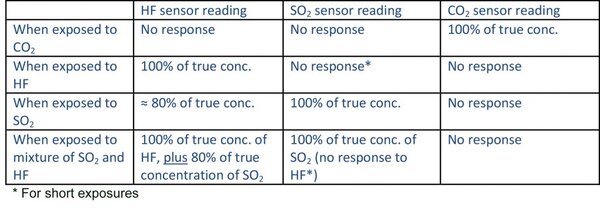Question:
I’ve spoken with a number of other gas detection suppliers. They always seem to run up against the same problem. We have both CO2 and HF that is produced in our process. The other suppliers say their SO2 sensor has a relative response to HF of 1:1. Is there anything we can do? Are your sensors any different than those of the other manufacturers?
Answer:
The answer is to use multiple sensors to rule in or rule out potential interfering gases.
CO2 does not affect SO2 or HF sensors. We use an IR sensor to measure CO2. The IR CO2 sensor is not affected by exposure to SO2 or HF.
The relative response of the HF sensor to SO2 is about 0.8. This is the only situation where you have a high relative response between one and another of the gases on the customer’s list.
The relative response of the SO2 sensor to HF is very low. For short exposures to HF gas, the SO2 sensor relative response should be close to zero. If the internal filters become saturated due to high exposure, the HF should theoretically produce a slight negative interfering effect on the SO2 sensor. However, I did not get a response even when I exposed an SO2 sensor to 10 ppm HCl gas (which we use as a surrogate for HF) for over 10 minutes.
Putting this information into a logic chart allows you to determine which gas is likely to be present:

Thus, in the event of simultaneous exposure to both SO2 and HF, the true concentration of SO2 is determined by the SO2 reading. The true concentration of HF is determined by subtracting the 80% of the value of the reading of the SO2 sensor from the reading from the HF sensor.
Let’s say you have a reading of 20 ppm from the HF sensor, and a reading of 10 ppm from the SO2 sensor. The true concentration of SO2 = 10 ppm. The true concentration of HF = (20 ppm) – (10 ppm X 0.8) = 12.0 ppm.
Relative responses vary between sensors, and can change a little over the life of the sensor. When you use relative response factors to calculate the actual concentration remember that relative response factors are approximate values!
HF sensors require a little extra effort when it comes to calibration. Also they usually need to be replaced after one year, when the warranty expires.
We have a Technical Note which discusses HF sensor calibration issues that is posted on our website.
The note discusses HF sensor calibration from the standpoint of the Micro IV, but the issues are exactly the same when the HF sensor is installed in a G460 multi-sensor instrument. It is likely that at least some of the customer’s prior negative experience with HF sensors had as much to do with calibration as with issues related to relative response. Also, HF sensors are very prone to exhibiting short term fluctuations due to abrupt changes in humidity. Breathing on the sensor, or putting your hand over the HF sensor causes the reading to fluctuate. The reading stabilizes as soon as the humidity stabilizes. Customers need to be careful to avoid abrupt changes in humidity, and to give the sensor time to stabilize when exposed to new conditions in the ambient atmosphere.
I hope this information was helpful.
